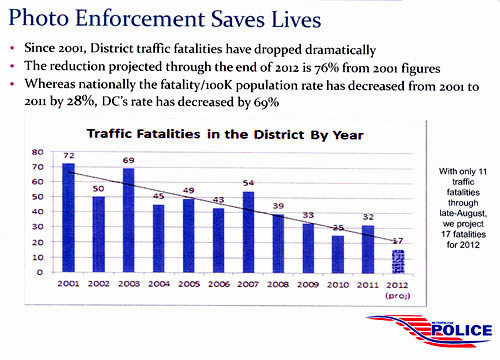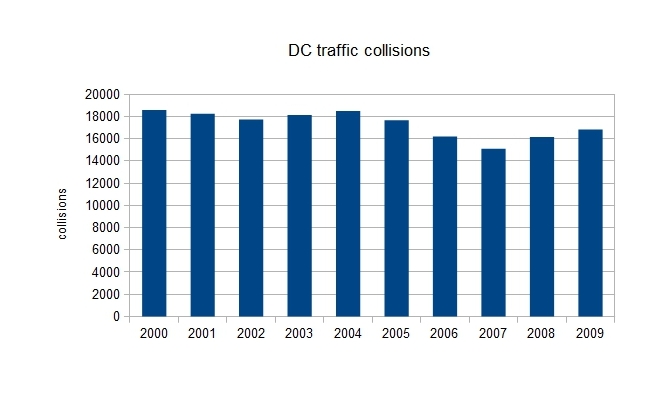Does “photo traffic enforcement” really save lives, as the MPD claims?
 The
Metropolitan Police Department (MPD believes that
their traffic cameras are responsible for much of the sharp decline
in traffic fatalities in the District: “Whereas nationally the
fatality/100K population has decreased from 2001 to 2011 by 28%, DC’s
rate has decreased by 69%”. The implication is that most of the
decrease in traffic fatalities in DC since 2001 is due to MPD “photo
enforcement”.
The
Metropolitan Police Department (MPD believes that
their traffic cameras are responsible for much of the sharp decline
in traffic fatalities in the District: “Whereas nationally the
fatality/100K population has decreased from 2001 to 2011 by 28%, DC’s
rate has decreased by 69%”. The implication is that most of the
decrease in traffic fatalities in DC since 2001 is due to MPD “photo
enforcement”.
Is this so? If
red-light cameras are reforming driver behavior at intersections,
and speed cameras are cauing lower vehicle speeds, one should expect
to see substantial reductions in traffic collisions, and in
pedestrian fatalities. But neither is in fact observed.
While the traffic death count in DC dropped by half during the 2000-2009
decade, the total
number of traffic collisions decreased by only about
9%. Between 2007 and 2009, the number of collisions actually
increased by 5%, even as the traffic fatality count decreased
by 30%.

How
can a modest decrease in collisions result in a large, ≈50%
reduction in fatalities? How can the fatality count continue to
decrease, even when the number of collisions is increasing? It seems
clear that safer cars are responsible for this reduction in
road fatalities. In 1989, Federal law began mandating passive
restraints in passenger cars, and recent model cars now feature front
and side air bags, crash-absorbing bodies, and passenger-protecting
cage structures to improve passenger survivability in collisions. So,
as older cars are retired and replaced by newer, safer cars, traffic
fatalities decline, in DC and nationwide.
These
safety features are certainly more effective at the moderate-speed
collisions of the city than at highway speeds, a plausible
explanation for the larger decrease in fatalities in the urbanized
District than nationwide.
Also,
despite the proliferation of red-light and speed cameras in the
District since 2001, pedestrian
deaths in DC have hardly changed: 11 in 2001, 13 in
2010. The figure shows pedestrian deaths in DC since 2000 (National Highway Traffic Safety Administration data), and total traffic
deaths with pedestrian deaths subtracted, for an approximate count of
vehicle occupant deaths (motorcycle and bicycle deaths will be
included). Clearly the big decrease in recent years has been in
vehicle occupant deaths, whereas pedestrian deaths have hardly
changed.
This
is consistent with the hypothesis that the reduction in traffic
fatalities is due largely to safer cars. Air bags and other passive
restraints that protect vehicle occupants do nothing for pedestrians.

The
static count in pedestrian deaths, while automobile fatalities were
decreasing, led to the recent worried observations that more
than half of D.C. traffic deaths in 2010 were pedestrians.
That wasn't because pedestrian deaths were up, but because vehicle
occupant deaths have gone down, while pedestrian deaths have remained
constant.
Traffic
cameras might conceivably play a contributing role to fatality
reduction, by lowering speeds at which collisions happen. That's
evidently what the MPD wants to believe; if traffic accidents aren't
much decreased, then it must be lower traffic speed that is reducing
traffic deaths. But the record on actual
speed reductions due to speed cameras and other
enforcement measures is, at best, mixed.
Easily
the best explanation for the decreasing fatality count on DC streets
is increased survivability of collisions by the occupants of
cars, thanks to the safety measures brought about stringent Federal
Government requirements. This explains why fatalities, predominantly
among vehicle occupants, are down sharply, though collisions are not
much decreased, and pedestrian fatalities remain unchanged.
The
MPD claim that their efforts are to be credited for much or most of
the fatality decrease on DC roads is just not credible, given the
relatively small decrease in the number of actual vehicle collisions,
and the absence of a significant decrease in pedestrian deaths.
Return to home
Page created October 5, 2012
 The
Metropolitan Police Department (MPD believes that
their traffic cameras are responsible for much of the sharp decline
in traffic fatalities in the District: “Whereas nationally the
fatality/100K population has decreased from 2001 to 2011 by 28%, DC’s
rate has decreased by 69%”. The implication is that most of the
decrease in traffic fatalities in DC since 2001 is due to MPD “photo
enforcement”.
The
Metropolitan Police Department (MPD believes that
their traffic cameras are responsible for much of the sharp decline
in traffic fatalities in the District: “Whereas nationally the
fatality/100K population has decreased from 2001 to 2011 by 28%, DC’s
rate has decreased by 69%”. The implication is that most of the
decrease in traffic fatalities in DC since 2001 is due to MPD “photo
enforcement”.

